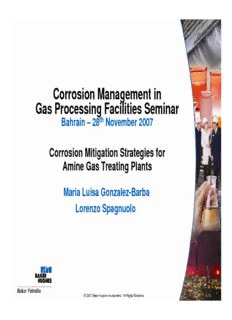
Corrosion Mitigation Strategies for Amine Gas Treating Plants PDF
Preview Corrosion Mitigation Strategies for Amine Gas Treating Plants
Corrosion Management in Gas Processing Facilities Seminar Bahrain – 28th November 2007 Corrosion Mitigation Strategies for Amine Gas Treating Plants Maria Luisa Gonzalez-Barba Lorenzo Spagnuolo ©2©020070 B7a Bkaekr eHru Hguhgehse Isn cInocrpoorpraotreadte. d A. l lA Rlli gRhigtsh tRse Rseesrveervde.d. AGENDA • Introduction and overview of Amine Units/Amine properties • Corrosion in Amine Gas Treating Plants – Contaminants - type and origin – Corrosion causes – Corrosion effects • Amine degradation – Heat Stable Amine Salts (HSAS) formation and management • Typical corrosion locations • Examples of corrosion in Gas Treating Plants • First steps to mitigate corrosion in Gas Plants ©2007 Baker Hughes Incorporated. All Rights Reserved. AGENDA (cont.) • Typical Metallurgy for Gas Plants • Baker Petrolite’s Amine Gas Treating Management Program – Advanced analytical testing and results interpretation – Effective chemical treatment program – Innovative corrosion monitoring program • Corrosion Case Studies from Europe • Summary and conclusions • Literary references ©2007 Baker Hughes Incorporated. All Rights Reserved. INTRODUCTION - ALKANOLAMINES • Alkanolamines are bases used in Gas Plants and Refineries to remove H S, Mercaptans and/or CO contaminants from natural gas, 2 2 reformed gas or refinery gases and LPG by a chemical absorption mechanism. – NH Group: is responsible of the acid gas absorption. 2 – OH Group: is responsible of the amine solubility in water. • Types of Alkanolamines – Primary Amine: MEA and DGA® (the most reactive amines). – Secondary Amine: DEA and DIPA amines. – Tertiary Amine: MDEA and TEA amines. MDEA < DEA < MEA < DGA® INCREASING BASE STRENGTH ©2007 Baker Hughes Incorporated. All Rights Reserved. MOLECULAR STRUCTURE OF AMINES USED IN GAS SWEETENING PRIMARY AMINES MONOETHANOLAMINE (MEA) MW = 61 DIGLYCOLAMINE (DGA®) MW = 105 H H N - CH - CH - OH N - CH - CH - O - CH - CH - OH 2 2 2 2 2 2 H H SECONDARY AMINES DIETHANOLAMINE (DEA) MW = 105 DIISOPROPANOLAMINE (DIPA) MW = 133 HO - CH - CH - N - CH - CH - OH HO - CH - CH - N - CH - CH -OH 2 2 2 2 2 2 | | | | H CH H CH 3 3 TERTIARY AMINES TRIETHANOLAMINE (TEA) MW = 149 METHYLDIETHANOLAMINE (MDEA) MW = 119 HO - CH - CH - N - CH - CH - OH HO - CH - CH - N - CH - CH - OH 2 2 2 2 2 2 2 2 | | CH - CH - OH CH 2 2 3 ©2007 Baker Hughes Incorporated. All Rights Reserved. COMMONLY USED AMINES – PROPERTIES MEA DGA® DEA DIPA MDEA Molecular Weight 61.1 101.5 105.1 133.2 119.2 Typical Concentration, wt% 15-20 45-50 25-30 30 35-50 Typical Lean Loading, 0.05-0.1 0.05-0.1 0.02 0.02 0.005- mol/mol 0.01 Typical Rich Gas Loading, 0.35 0.40 0.40 0.40 0.45 mol/mol Typical Steam Use, #/gal 1.5 1.5 1.2 1.1 1.0 Pure Amine Relative Price 0.50 0.95 0.50 0.95 1.00 Heat of Reaction with CO , 825 850 653 550 475 2 BTU/lb Heat of Reaction with H S, 820 674 511 475 455 2 BTU/lb ©2007 Baker Hughes Incorporated. All Rights Reserved. ADVANTAGES AND DISADVANTAGES OF EACH AMINE MEA (Monoethanolamine): Typical concentration 15 - 18 weight % ADVANTAGES DISADVANTAGES • Low cost • Not selective in presence of CO 2 • Degradation products can be • CO , COS and CS can irreversibly 2 2 removed by reclaiming degrade the amine • Degradation products are very corrosive • Degraded amine has lower acid gas removal capacity • High energy required for its regeneration • Significant vaporization losses due to high vapor pressure ©2007 Baker Hughes Incorporated. All Rights Reserved. ADVANTAGES AND DISADVANTAGES OF EACH AMINE DEA (Diethanolamine): Typical concentration 25 - 30 weight % ADVANTAGES DISADVANTAGES • Moderate cost • Not selective in presence of CO 2 • Degrades less with CO and • CO , COS irreversibly degrade 2 2 COS than MEA the amine • Degradation products are less • Degraded amine has lower acid corrosive than MEA gas removal capacity • Purification can be made by vacuum distillation • Less energy required for its regeneration than MEA ©2007 Baker Hughes Incorporated. All Rights Reserved. ADVANTAGES AND DISADVANTAGES OF EACH AMINE DGA® (Diglycolamine): Typical Concentration 50 weight % ADVANTAGES DISADVANTAGES • Can achieve low specification • High cost also under critical conditions • Degradation products can be • Not selective in presence of CO 2 removed by reclaiming • CO , COS and CS irreversibly 2 2 degrade the amine • Degradation products are very corrosive • High solubility of the aromatic, olefins and heavy hydrocarbons in DGA • Very high energy required for regeneration DGA is registered trademark of Huntsman Petrochemical Corporation ©2007 Baker Hughes Incorporated. All Rights Reserved. ADVANTAGES AND DISADVANTAGES OF EACH AMINE DIPA (Di-isopropanolamine): Typical Concentration 27 weight % ADVANTAGES DISADVANTAGES • Some selectivity in presence • High cost of CO 2 • Purification can be made by • CO and COS irreversibly 2 vacuum distillation degrade the amine • Relatively moderate energy requirement for regeneration ©2007 Baker Hughes Incorporated. All Rights Reserved.
Description: